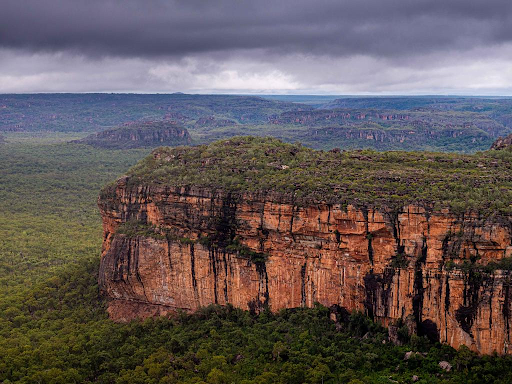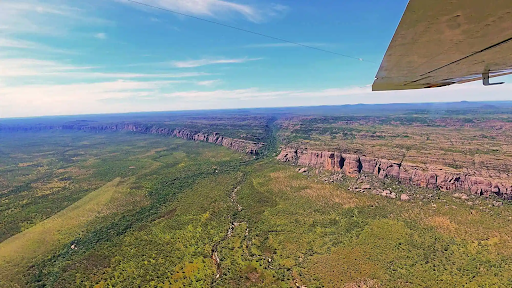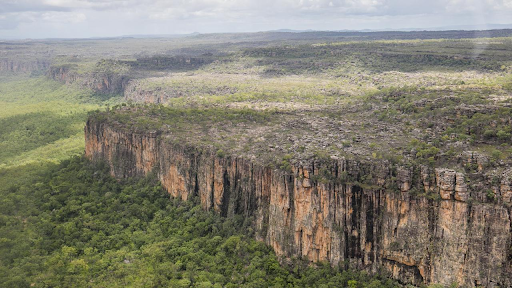Nestled within the sweeping landscapes of the Northern Territory, the Kakadu Escarpment stands as a testament to nature’s artistry and time’s passage. A two-day tour of this magnificent region offers a glimpse into an ancient world, where rugged cliffs rise dramatically from the surrounding lowlands, creating a boundary between two distinct ecosystems. This article will transport you to this iconic Australian landmark, teasing out its rich layers of natural beauty, profound cultural heritage, and diverse wildlife. Join us as we uncover the secrets of Kakadu’s majestic escarpment, and learn why this destination beckons travelers from around the globe.

The Birth of the Kakadu Escarpment
The Kakadu Escarpment’s story begins millions of years ago, crafted by geological forces that shaped the Earth’s surface. Erosion and tectonic activity carved out the steep cliffs and gorges, bequeathing them their current form. This natural fortress has cradled the region’s ecosystems, fostering a refuge for myriad species and forming a natural reservoir for the area’s rainfall. As a principal feature of Kakadu National Park, the escarpment is more than a geographic landmark; it is a cornerstone of the environment’s past, present, and future.
Cultural Significance of Kakadu
Long before it became a national park, Kakadu’s escarpment was home to Indigenous Australians, whose ancestors left behind a tapestry of rock art that narrates their deep spiritual connection to the land. These ancient paintings are sacred texts, depicting everything from daily life to the dreamtime stories that form the backbone of their culture. The escarpment today stands as a cultural crossroads, where the knowledge of the elders is passed down to new generations, ensuring that the traditions and stories remain alive and honored.

Navigating the Rugged Terrain
With a range of trails etched into its surface, the Kakadu Escarpment invites adventurers to explore its breadth. From scenic lookouts to hidden waterfalls, each path offers its rewards. Travelers should be well-equipped and informed, as the terrain can be challenging. It’s crucial to carry sufficient water, wear sturdy hiking boots, and familiarize oneself with the routes—essential steps for a safe and enjoyable hike. The experience of journeying through this ancient and dramatic landscape is both humbling and invigorating.
The Flora and Fauna of the Kakadu Escarpment
The escarpment’s flora and fauna are a testament to the biodiversity of Kakadu National Park. Unique species, such as the black wallaroo, find sanctuary in its cliffs, coexisting with a host of endemic birds, reptiles, and plants. The escarpment operates like an ecological ark, preserving species that are vulnerable to changes in their habitat. However, this biodiversity hotspot faces threats, from invasive species to climate change, making conservation efforts vital for ensuring the continuous harmony between the escarpment’s inhabitants and their home.
The Escarpment Through Seasons
The Kakadu Escarpment undergoes a dramatic transformation with the shifting seasons. During the wet season, water cascades down its face, creating temporary waterfalls and pooling into billabongs at its base. In the dry season, the land bares its bones, revealing ancient rock formations and allowing fuller access to exploratory visitors. These seasonal shifts don’t just alter the landscape; they dictate the rhythm of life for the escarpment’s plants and animals, and they influence the best times for humans to witness its splendor in full force.
Adventures Await
A voyage to the Kakadu Escarpment is not devoid of thrills and spills. With activities like fishing, boating, and even spotting the majestic saltwater crocodile, there’s never a dull moment. Visitors can immerse themselves in the vast wilderness, partaking in guided ‘Kakadu 2 day tours’ to gain a comprehensive experience or opting for shorter excursions focusing on particular attractions.
- Comprehensive Kakadu 2 day tour: Ideal for travelers looking to delve deep into the park’s offerings.
- Specialized photography safaris: Perfect for those wanting to capture the escarpment’s raw beauty.
Photography and Memory Making
As a photographer’s paradise, the Kakadu Escarpment challenges one to capture the essence of its enigmatic grandeur. Photography enthusiasts come here chasing the golden light that paints the cliffs at sunset or the misty dawns that shroud the gorges. Combining patience with skill, photographers can immortalize scenes of untouched wilderness, leaving with more than just memories but also snapshots of a landscape that continues to evolve and inspire.
Planning Your Visit
Before you embark on your Kakadu Escarpment adventure, thoughtful planning can ensure a smooth and memorable experience. Accommodations ranging from campgrounds to luxury lodges nestle within the park’s boundaries, providing options for every taste and budget.
| Accommodation Type | Features | Approximate Price Range |
|---|---|---|
| Campgrounds | Basic facilities, close to nature | $10 – $30 per night |
| Budget Lodges | Comfortable with essential amenities | $80 – $150 per night |
| Luxury Lodges | Upscale amenities, premium services | $250 – $600 per night |
Lastly, all visitors should ensure they have paid the appropriate park fees and understand the rules and regulations that help protect this pristine area for future generations.
Conclusion
In wrapping up, the Kakadu Escarpment offers more than just a stunning view. It’s a place where history, culture, and nature intertwine to produce an unforgettable experience. Whether you’re an avid hiker, a history enthusiast, or simply someone who appreciates natural beauty, the escarpment provides a unique adventure that’s as educational as it is exhilarating. Plan your trip well, respect the sacred land, and carry the spirit of Kakadu with you long after you depart.
FAQs
Q1: What is the best time of year to visit the Kakadu Escarpment?
A1: The best time to visit is during the dry season, from May to October, when the weather is cooler, the skies are clear, and the roads and trails are more accessible.
Q2: Do I need a permit to visit the Kakadu Escarpment?
A2: Yes, visitors need to obtain a park pass to enter Kakadu National Park, which includes access to the escarpment.
Q3: How difficult are the hiking trails around the Kakadu Escarpment?
A3: The hiking trails vary in difficulty from easy walks to challenging treks. It’s important to assess your fitness level and prepare accordingly, taking into account the rugged terrain.
Q4: Can you see Aboriginal rock art at the Kakadu Escarpment?
A4: Yes, the Kakadu Escarpment is home to some of the most significant Aboriginal rock art sites in Australia. Visitors can see ancient paintings that offer a window into the past.
Q5: Are there any guided tours available for the Kakadu Escarpment?
A5: Yes, there are a range of guided tours available, including cultural tours led by Indigenous guides, which can offer deeper insights into the significance of the escarpment and its surroundings.
